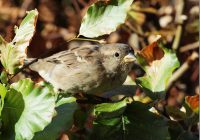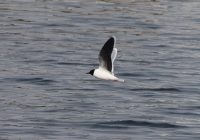Dr Phil Smith’s Wildlife Notes
November 2016
After an exceptionally dry early autumn, it was expected, even hoped, that the heavens would open during November. In the event, there was significant rainfall on 12 days during the first three weeks, though in no great quantity, high pressure then returning, with dry conditions and frosty mornings. Water-levels at the Devil’s Hole slack hardly increased at all, being well below the ground surface all month. With the onset of colder weather, I started feeding the garden birds, as usual, and was pleased to be entertained by my flock of House Sparrows creeping mouse-like through the dead leaves. I counted a maximum of 20 sparrows, very similar to last year. They were joined by cheeky Starlings with a few Blackbirds, Robins and Dunnocks. Less welcome were strapping Wood Pigeons and even the occasional Magpie and Jackdaw taking more than their fair share of the food.
The relatively mild autumn meant that many wildflowers were still out in the dunes. A visit to Birkdale Green Beach with Patricia Lockwood on 2nd provided a few additional species for our annual list, including blue-flowered Flax, a new plant for the site. The attractive pink Common, Seaside and hybrid Centauries were also still in flower. A Buzzard soared overhead mobbed by Carrion Crows, while a flight of 12 Whooper Swans came in off the sea, calling evocatively in the gloom. New to the inventory of plants for the Sefton Coast was a conifer poking above the parapet of the Woodvale railway bridge. The upright cones indicated a silver fir but I had to take a piece home to confirm European Silver Fir Abies alba.
Mosses and liverworts tend to take over from the flowering plants as botanical attractions in late autumn. A visit to Devil’s Hole with Joshua Styles produced 13 kinds, including Yellow Starry Feather-moss Campylium stellatum not recorded here before and an indicator species for one of the immature dune-slack plant communities. I struggle to identify this group, so relied heavily on Joshua, helped by the excellent Mosses & Liverworts of Britain & Ireland a field guide published by the British Bryological Society.
Easily the wildlife highlight of the month came on 10th when a morning phone call from Tim Vaughan alerted me to a flock of 10 Waxwings at Range Lane. Arriving a few minutes later, I could see no sign of them but a female Sparrowhawk snatched a squawking Blackbird out of a Hawthorn bush right in front of me. Then, suddenly, there they were – Waxwings – a silhouette like a Starling with a distinctive pale tip to the tail readily visible in flight. They dropped conveniently into the same Hawthorn and began gorging on the abundant berries, showing off their lovely dusky-pink plumage and rakish crest. I watched them for about an hour, joined by several other locals. There had been an influx of Waxwings into the country from Scandinavia but they moved on the same day, none being reported subsequently.
Skeins of Pink-footed Geese acting as an alarm clock prompted a visit to Downholland Moss just inland of Formby on 26th. Sure enough, there was a large flock on the grass fields right next to the road. Using my car as an impromptu hide, I estimated 2300 geese, though a careful telescope search revealed only Pinkfeet with no fellow-travellers.
Much time during the month was spent writing up summer surveys, the intention being to publish as many as possible. This can be difficult to achieve in practice as most scientific journals have stringent acceptance criteria. It was all the more pleasing, therefore, to have an article I wrote with Claire Boardman on the rate of growth of Japanese Rose bushes appear in the Journal of Coastal Conservation, while another on Green-winged Orchids at Altcar with Steve Cross was published in the online journal Conservation Evidence. I also enjoyed presenting a paper on volunteer recording on the Sefton Coast at the Biodiverse Society conference at Brockholes. This well-organised and successful event was attended by over 90 people.
Steve White sent me details of a Little Gull ringed at Seaforth in April 1978 and found dead 2800km away near Arkhangelsk in Russia in August 1987. Thought to be the first recovery of a British-ringed Little Gull in Russia, why it took nearly thirty years to report the find is not clear.
Ben Hargreaves of the Wildlife Trust’s Plan Bee project sent me a list of 26 bees, wasps and ants recorded at Freshfield Dune Heath Nature Reserve in August. They included the Swollen-thighed Blood Bee Sphecodes crassus which is probably the first record in the Northwest for this mainly southern species. The Blood Bees are parasites of other solitary bees, the likely host in this case being the Long-faced Furrow Bee Lasioglossum punctatissimum which was also found on the heath and is scarce in northern England. Ben’s findings reflect the remarkable biodiversity of the Sefton Coast, often involving creatures that hardly anyone notices.




